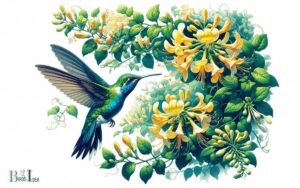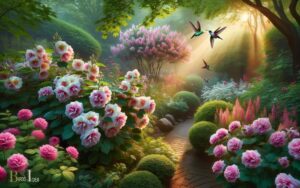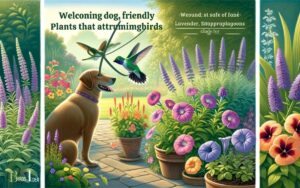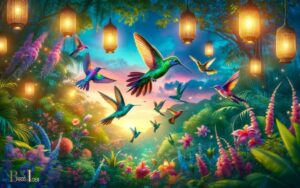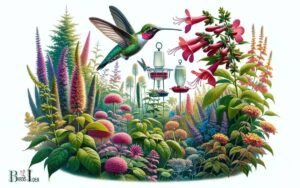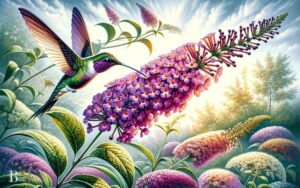Desert Plants That Attract Butterflies and Hummingbirds!
Desert plants that attract butterflies and hummingbirds include species such as the Mexican Flame Vine, Penstemon, Desert Milkweed, Red Yucca, and the Chuparosa.
These plants have adapted to arid environments and provide nectar-rich flowers that are irresistible to both pollinators.
Butterflies and hummingbirds are attracted to plants that offer abundant nectar and are well-suited to the growing conditions in desert areas.
Desert-adapted plants often have vibrant flowers and extended blooming periods, which are essential for supporting wildlife in these ecosystems.
Here are some examples of desert plants attractive to these pollinators:
Incorporate desert plants like the vibrant Mexican Flame Vine and nectar-rich Penstemon in your garden to create a haven for butterflies and hummingbirds, adding life and color to the arid landscape.
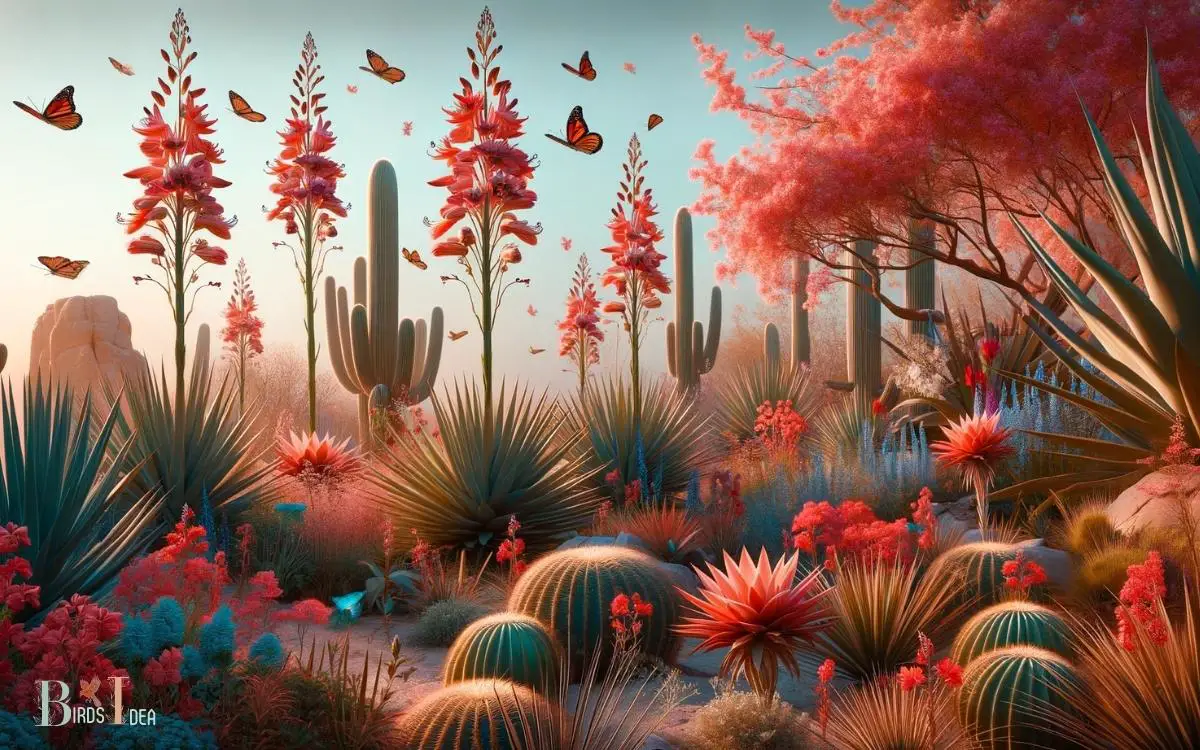
Key Takeaway
The Benefits of Attracting Butterflies and Hummingbirds
By attracting butterflies and hummingbirds, desert plants contribute to the pollination of flowers and the overall biodiversity of the ecosystem.
Butterflies and hummingbirds are important pollinators, transferring pollen from one flower to another as they feed on nectar.
This process is crucial for the reproduction of many plant species. Desert plants have adapted to attract these pollinators through the production of nectar-rich flowers with bright colors.
By doing so, they ensure the continuation of their species and contribute to the overall health and diversity of the desert ecosystem.
Additionally, the presence of butterflies and hummingbirds indicates a healthy and balanced environment, as these creatures are sensitive to changes in their habitat.
Therefore, the attraction of these pollinators to desert plants serves as an indicator of the ecosystem’s well-being.
Top Nectar-Rich Plants for Butterflies and Hummingbirds
Discussing the top nectar-rich plants for attracting butterflies and hummingbirds is essential for creating a thriving desert garden ecosystem.
These plants not only provide a food source for these pollinators but also enhance the overall biodiversity of the garden.
When selecting plants, it’s crucial to consider their nectar production and the specific needs of butterflies and hummingbirds.
The following nectar-rich plants are particularly attractive to these pollinators:
- Penstemon (Penstemon spp.): These plants produce tubular flowers with abundant nectar, making them highly appealing to hummingbirds.
- Milkweed (Asclepias spp.): Known for attracting butterflies, milkweed provides ample nectar and is essential for the survival of monarch butterflies.
- Agastache (Agastache spp.): With its long-blooming and fragrant flowers, agastache is a favorite of both butterflies and hummingbirds.
Choosing the Right Location for Your Desert Garden
The right location for your desert garden plays a crucial role in attracting butterflies and hummingbirds to the desert plants.
When selecting a location, consider the sun exposure, wind patterns, and proximity to water sources.
Butterflies and hummingbirds are attracted to areas with ample sunlight, so choose a spot that receives at least six hours of direct sunlight per day.
Additionally, wind can affect the delicate balance of nectar-producing flowers, so it’s essential to choose a location shielded from strong winds.
Proximity to water sources is also important as both butterflies and hummingbirds need water for drinking and bathing.
By selecting a location with these considerations in mind, you can create an environment that is conducive to attracting and supporting these beautiful creatures.
Essential Elements for Creating a Butterfly and Hummingbird Oasis
Creating a butterfly and hummingbird oasis in the desert requires careful consideration of the ideal plant species, as well as a well-planned watering and maintenance routine.
The selection of plant species should focus on those that provide nectar, host plants for caterpillars, and shelter for butterflies and hummingbirds.
Additionally, ensuring proper watering and maintenance practices is crucial to support the growth and health of these plants, ultimately attracting and sustaining these delicate and beautiful creatures in the desert environment.
Ideal Plant Species
One can attract butterflies and hummingbirds to a desert oasis by planting species such as agave, desert willow, and penstemon. These plants provide essential nectar and habitat for these pollinators.
- Agave: With its towering flower stalks and abundant nectar, agave is a favorite of hummingbirds and butterflies.
- Desert Willow: This drought-tolerant tree produces showy, trumpet-shaped flowers that are irresistible to hummingbirds and butterflies.
- Penstemon: Also known as beardtongue, penstemon’s tubular flowers are rich in nectar, making it a magnet for both butterflies and hummingbirds.
These ideal plant species not only attract but also sustain butterflies and hummingbirds, contributing to the creation of a thriving oasis in the desert landscape.
Watering and Maintenance
Watering and maintaining desert plants is essential for creating a butterfly and hummingbird oasis. Desert plants have evolved to survive in arid environments with minimal water.
When establishing a butterfly and hummingbird oasis, it is crucial to mimic their natural habitat by providing well-draining soil and watering practices that imitate the sporadic, heavy rainfall characteristic of desert regions.
Drip irrigation systems or hand watering at the base of plants are recommended to prevent excess moisture, which can be detrimental to desert plant species. Mulching can help retain soil moisture and regulate temperature.
Regular maintenance tasks such as pruning, removing dead foliage, and monitoring for pests and diseases are important to ensure the health and vitality of the plants, ultimately creating an inviting environment for butterflies and hummingbirds.
Creating a Colorful and Fragrant Haven for Wildlife
By strategically selecting and arranging plants, gardeners can create an inviting oasis for butterflies and hummingbirds.
Incorporating a variety of flowering plants with different blooming periods ensures a constant supply of nectar throughout the year.
Choosing plants with a range of colors, such as red, orange, and purple, can attract a diverse array of pollinators.
Fragrant plants like desert lavender and evening primrose can further enhance the garden’s appeal to wildlife.
Additionally, providing sources of water, such as shallow dishes or small fountains, can attract and sustain these visitors.
Creating a habitat with a mix of nectar-rich flowers and aromatic blooms offers a visually stunning and enticing environment for butterflies and hummingbirds to thrive.
Maintenance Tips for a Thriving Butterfly and Hummingbird Garden
To maintain a thriving butterfly and hummingbird garden, it is crucial to carefully consider the watering frequency for desert plants.
Overwatering can be detrimental to these plants, so it is important to strike a balance and provide just enough water to keep them healthy.
Additionally, choosing native plant species that are well-suited to the desert environment will help ensure the garden thrives and continues to attract butterflies and hummingbirds.
Watering Frequency for Desert Plants
Maintaining a thriving butterfly and hummingbird garden in the desert involves carefully managing the watering frequency for the desert plants.
Desert plants have adapted to survive in arid conditions, so their watering needs differ from those of traditional garden plants.
When watering desert plants for a butterfly and hummingbird garden:
- Water deeply but infrequently to encourage deep root growth.
- Monitor the soil moisture levels to avoid overwatering, which can lead to root rot.
- Consider using drip irrigation or soaker hoses to deliver water directly to the plants’ roots.
Choosing Native Plant Species
Native plant species play a crucial role in maintaining a thriving butterfly and hummingbird garden in the desert.
When selecting native plants for a butterfly and hummingbird garden, it is essential to consider the specific needs of these pollinators.
Native plants have co-evolved with local pollinators and are well-suited to provide the necessary nectar, pollen, and habitat.
They also require less water and maintenance once established, making them an environmentally friendly choice.
A diverse selection of native plants can offer a continuous bloom throughout the growing season, ensuring a consistent food source for butterflies and hummingbirds.
Additionally, native plants support the overall ecosystem by providing food and habitat for other wildlife.
By choosing native plant species, gardeners can create a sustainable and thriving environment for butterflies and hummingbirds in the desert.
Adding Water Features to Enhance Wildlife Attraction
Enhancing wildlife attraction in desert landscapes can be achieved by adding water features to provide essential hydration for butterflies and hummingbirds.
Water features not only offer a vital water source but also create a habitat that attracts and sustains wildlife.
When considering adding water features to enhance wildlife attraction in desert landscapes, it is essential to take into account the following:
- Placement: Position water features strategically to provide easy access for wildlife while also considering the overall landscape design.
- Maintenance: Regularly maintain water features to ensure water quality and prevent the breeding of mosquitoes.
- Safety: Implement safety measures to prevent accidental drowning of small animals and ensure that the water features are safe for wildlife.
Careful consideration and implementation of water features can significantly enhance the presence of butterflies and hummingbirds in desert environments, promoting a thriving ecosystem.
Companion Plants to Enhance Your Butterfly and Hummingbird Garden
Companion planting involves strategically placing plants that mutually benefit each other in terms of growth, pest control, and attraction of pollinators like butterflies and hummingbirds.
When enhancing a butterfly and hummingbird garden, certain companion plants can further promote the thriving ecosystem.
For instance, planting milkweed alongside nectar-rich flowers can provide essential food sources for both adult butterflies and hummingbirds.
Additionally, including herbs such as dill, fennel, or parsley can attract butterflies while also serving as host plants for their caterpillars.
Furthermore, incorporating native grasses and shrubs can offer shelter and nesting sites for hummingbirds.
Understanding the symbiotic relationships between different plant species can significantly contribute to the success of a butterfly and hummingbird garden, creating a harmonious environment for these pollinators to thrive.
Conclusion
Creating a butterfly and hummingbird oasis in your desert garden can provide a colorful and vibrant haven for wildlife.
By choosing the right location, incorporating nectar-rich plants, and adding water features, you can attract these beautiful creatures and enhance the biodiversity of your outdoor space.
Just as a desert oasis provides sustenance and shelter for all who visit, your garden can become a vital sanctuary for butterflies and hummingbirds, adding a touch of natural beauty to your surroundings.

